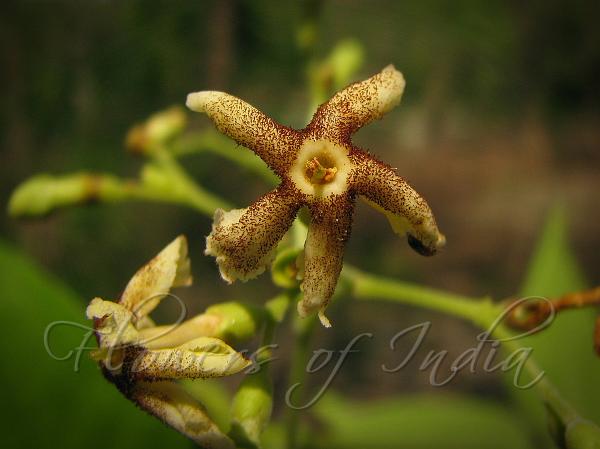|
| Weaver's Beam Tree |
|

|

| File size | 635011 |
| Original date | 5/31/14 2:48 PM |
| Resolution | 2048 x 1536 |
| Flash | Flash did not fire, auto |
| Focal length | 6.0mm |
| Exposure time | 1/1600s |
| Aperture | 7.1 |
| Focus Distance | |
| Metering Mode | Multi-segment |
| Camera make | Canon |
| Camera model | Canon PowerShot S5 IS |
| Sensor type | OneChipColorArea |
|
|
|
|
Photo: |
Botanical name: Schrebera swietenioides Family: Oleaceae (Jasmine family)
Weaver's Beam Tree is a moderate sized deciduous tree, growing up to 20 m
tall, with thick grey bark. Leaves are pinnate, with 3-4 pairs of opposite
leaflets, and a terminal one. Leaflets are ovate, entire, unequal-sided,
petioles thickened at the insertion of leaflets. Flowers are yellowish
white, variegated with brown, in terminal trichotomous, corymb-like,
compound clusters. Flowers are fragrant at night. Flower tube is funnel-
shaped, 8-12 mm long. Petals are 5-7, widely spreading, wedg-shaped,
blunt, with brown glandular raised dots on the upper side. Capsule is the
size of a hen's egg, pear-shaped, woody, hard, scabrous, 2-celled, seeds 4
in each cell, pendulous, irregularly oval, compressed, produced into a
long membranous wing. The wood is used by weavers to make the beam of the looms. Flowering: February-April.
Medicinal uses: The roots, bark and leaves are bitter, acrid,
appetising, digestive, thermogenic, stomachic, depurative, constipating
urinary astringent and anthelmintic. The fruits are reported to be useful
in curing hydrocele.
The roots, bark and leaves are bitter, acrid,
appetising, digestive, thermogenic, stomachic, depurative, constipating
urinary astringent and anthelmintic. The fruits are reported to be useful
in curing hydrocele.
Medicinal uses:
 The roots, bark and leaves are bitter, acrid,
appetising, digestive, thermogenic, stomachic, depurative, constipating
urinary astringent and anthelmintic. The fruits are reported to be useful
in curing hydrocele.
The roots, bark and leaves are bitter, acrid,
appetising, digestive, thermogenic, stomachic, depurative, constipating
urinary astringent and anthelmintic. The fruits are reported to be useful
in curing hydrocele.
| Identification credit: Satish Phadke, Shrikant Ingalhalikar | Photographed in Maharashtra. |
• Is this flower misidentified? If yes,